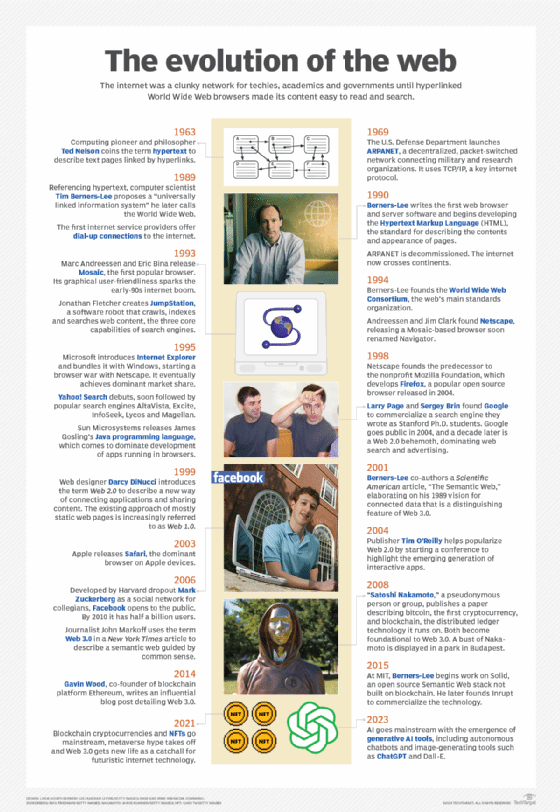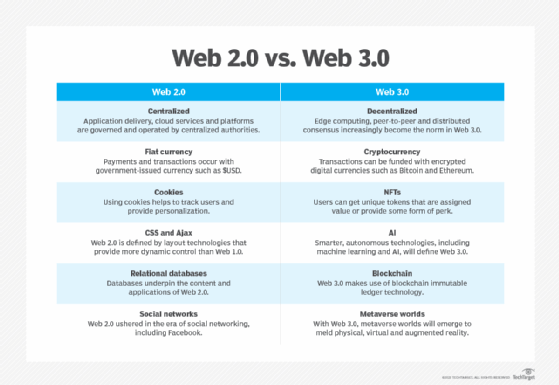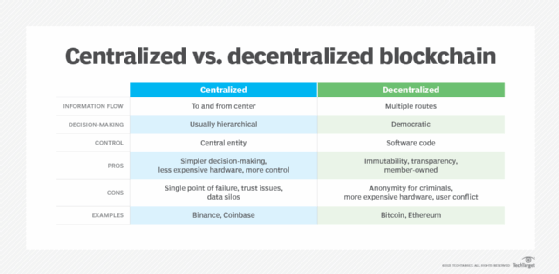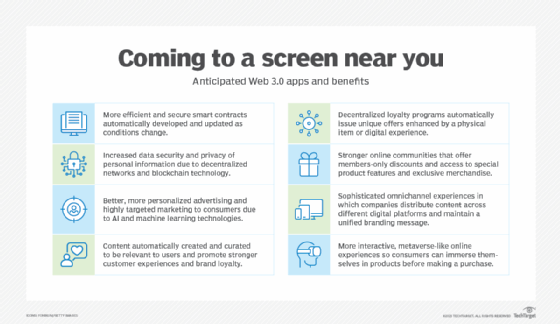What is Web 3.0 (Web3)? Definition, guide and history
What if the web could conjure up exactly the information you needed in exactly the format you wanted -- before you knew enough to ask for it?
It would certainly be a much different, maybe even desirable -- if a little creepy -- internet experience. Yet it could someday be the reality of Web 3.0, the next version of the web.
Thanks to the changes that proponents of Web 3.0 claim it will bring, the internet will be much smarter, because artificial intelligence will be ubiquitous. All the world's data will be unified in a so-called Semantic Web. Everyday users will have more say than wealthy corporations about how their personal information is used. Banks will be irrelevant as people exchange digital currencies and records without intermediaries.
Whether Web 3.0 comes to pass, especially in the form currently envisioned, remains an open question. What's clear is that interest in Web 3.0 has never been higher. Enterprises are ready to learn enough about Web 3.0 to decide what actions to take, if any.
This guide provides answers to common questions and has hyperlinks to articles that go into depth about the business opportunities and risks. It also has detailed explanations of key Web 3.0 concepts, such as the effects of decentralization on web governance and data management, and what enterprises can do today to test the Web 3.0 waters.
What is Web 3.0 (Web3)?
Web 3.0 describes the next evolution of the World Wide Web, the user interface that provides access to documents, applications and multimedia on the internet.
Web 3.0 is still being developed, so there isn't a universally accepted definition. Even the proper spelling isn't nailed down, with analyst firms like Forrester, Gartner and IDC toggling between "Web3" and "Web 3.0."
What is clear, though, is that Web 3.0 will place a strong emphasis on decentralized applications and probably make extensive use of blockchain-based technologies. It will also use machine learning and AI to empower a more intelligent and adaptive web.
Evolution of the web
If it comes to pass, Web 3.0 will be the successor to two previous generations of the web.
The first generation, referred to as Web 1.0, was invented in 1989 by Tim Berners-Lee, a British computer scientist who applied the hypertext concepts for linking digital text proposed in 1963 by Ted Nelson, an American information technology pioneer. Besides programming the first browser, Berners-Lee wrote the Hypertext Markup Language (HTML), which tells browsers how to display content, as well as the Hypertext Transfer Protocol (HTTP) specifying how web servers transfer files to browsers. He also started designing software for a "Semantic Web" that would link data across web pages, but hardware constraints prevented its implementation.
The public was not much aware of the web until 1993 with the release of Mosaic, the first popular browser, later renamed Netscape Navigator. Similar user-friendly graphical browsers followed, including Microsoft Internet Explorer and, much later, Apple Safari. The first popular search engines -- familiar names like Yahoo! Search, Lycos and AltaVista -- arrived on the scene, but by 2004 Google had put many of them out of business.
Around the turn of the millennium, experts began promoting the idea of an upgraded web that would be more interactive, calling it Web 2.0. They started referring to the existing web of basic connectivity to mostly static websites as Web 1.0. Berners-Lee fleshed out his Semantic Web concept by co-authoring an article in Scientific American. Publisher Tim O'Reilly helped promote Web 2.0 by starting a conference dedicated to it.
The dream of an interactive web came to fruition several years later with the skyrocketing popularity of social networks like Facebook. The World Wide Web Consortium, the web's standards body, released a Semantic Web standard. Around the same time, two essential Web 3.0 technologies were born: cryptocurrency and blockchain. Prominent journalists and technologists, including Gavin Wood, co-founder of Ethereum, a prominent blockchain platform, began to popularize the terms Web 3.0 and Web 3 to signify a decentralized, semantically aware version of the web.

Why is Web 3.0 important?
If decentralizing the web's architecture delivers even a portion of the benefits promised by Web 3.0 proponents, it could fundamentally alter how people interact on the web and how companies make money from goods and services.
Web 2.0 giants like Amazon, Google and Facebook parent Meta grew quickly by collecting and centralizing petabytes of customer data and monetizing it in myriad ways. Web 3.0's global peer-to-peer network could be the great leveler that makes it hard for such companies to grow by hoarding data. Individuals will have more control over web content and who can access and profit from their personal data.
Web 3.0 business opportunities, by contrast, are likely to center around exploiting this new ability to tailor web products and services to the individual. For example, Web 3.0 marketing capabilities could help companies strike a better balance between privacy and personalization than is possible with today's web. The downside: They may find Web 3.0's strong privacy protections a barrier to how they already do digital marketing.
The greater transparency provided by immutable blockchain ledgers could improve customer service, as both parties have access to the record of their transactions. Businesses could more easily monitor their supply chains by using decentralized apps to break down data silos and see suppliers' activities. Sharing real-time information among supply chain participants could reduce shortages and speed up deliveries.
Web 3.0 is also important as the infrastructure for the metaverse, a proposed 3D virtual world in which digital representations of people, called avatars, interact and conduct business. The metaverse, like Web 3.0, doesn't exist yet, and it will likewise rely on blockchain or a comparable decentralized technology for its data infrastructure and finances, as well as on AI to make it more responsive to the wishes of users.
The metaverse and Web 3.0 are interdependent at the technical and conceptual levels and, therefore, likely to evolve in tandem. The metaverse probably won't come to pass until its Web 3.0 underpinnings are firmly established.
How will Web 3.0 work?
In Web 1.0 and 2.0, HTML defined the layout and delivery of webpages. It will continue to be foundational in Web 3.0, but how it connects to data sources and where those data sources reside will probably be different.
Many websites and nearly all applications on Web 2.0 rely on some form of centralized database to deliver data and enable functions in applications. On Web 3.0, applications will instead use a decentralized blockchain that lacks an arbitrary central authority. In theory, this more democratic way of creating and affirming information will give users more control over the web and how their personal data is used.
Another difference between Web 2.0 and 3.0 is that Web 3.0 will give AI and machine learning more prominent roles in delivering relevant content to each user, instead of content others have chosen to provide. While Web 2.0 essentially enables users to contribute to and sometimes collaborate on site content, Web 3.0 will most likely turn these jobs over to the Semantic Web and AI.
Web 3.0 will thus be more "intelligent" and responsive because data will be more logically organized in the Semantic Web structure that Berners-Lee envisioned for the first version of the web, and AI will be more adept at understanding it.
The decentralized autonomous organization (DAO), an emerging governance mechanism in today's blockchain and Web 3.0 communities, could also revolutionize management of the web by wresting control from central authorities and devolving it to self-governed digital communities.
And because Web 3.0 also fundamentally relies on cryptocurrency rather than government currency, financial transactions will be conducted on decentralized blockchains rather than through the current financial service companies.
Both Web 1.0 and Web 2.0 were primarily built with the IPv4 addressing space. As a function of the web's massive growth over the decades, Web 3.0 will need far more internet addresses, which is what IPv6 provides.

Key Web 3.0 features and technologies
Several key Web 3.0 features define what this third generation of the web will likely be all about:
- Decentralized. Unlike the first two generations of the web, where governance and applications were largely centralized, Web 3.0 will deliver applications and services through a distributed approach that doesn't depend on a central authority.
- Blockchain-based. Blockchain decentralization is the enabler for Web 3.0's distributed applications and services. With blockchain, data is managed and validated on a broadly distributed, peer-to-peer network. Blockchain also employs a theoretically immutable ledger of transactions and activity, which helps to verify authenticity and build trust among blockchain participants.
- Cryptocurrency-enabled. Cryptocurrency is a key feature of Web 3.0 that is expected to largely replace the "fiat currency" issued by government central banks.
- Semantically organized. The idea behind the Semantic Web is to categorize and store information in a way that helps "teach" an AI-based system what data means. Websites will be able to understand the words in search queries the same way a human would, enabling them to generate and share better content.
- Autonomous and artificially intelligent. More overall automation is a critical feature of Web 3.0, and it will largely be powered by AI. Websites equipped with AI will filter through and provide the data individual users need.

Web 3.0 use cases and applications
Web 3.0 use cases are expected to draw heavily on the web's emerging, AI-driven ability to understand users' intentions and preferences and tailor the content it delivers to them based on personal data that the users control. Much of the content will be automatically curated and delivered, saving companies time and money.
With blockchain at its foundation, Web 3.0 will enable new applications and services based on blockchain technologies in active use today. They include the following:
- NFTs. Non-fungible tokens (NFTs) are a type of unique cryptographic asset used to create and authenticate ownership of digital assets. NFTs will be important in how things of value are created and exchanged on Web 3.0.
- DeFi. Decentralized finance (DeFi) is an emerging blockchain technology that could be the basis for Web 3.0's decentralized financial services.
- Cryptocurrency. Cryptocurrencies like Bitcoin are blockchain-based digital currencies that use cryptography to secure the processes involved in generating monetary units, conducting transactions and verifying changes of ownership. Crypto will be the Web 3.0 coin of the realm, according to supporters.
- dApps. Decentralized applications (dApps) are open source applications built on decentralized blockchains. They can be augmented by others, with a record of such changes recorded on the blockchain's distributed ledger. There are already dApps for middleware, charitable donations and social media platforms, among thousands of others.
- Smart contracts. A type of dApp, the smart contract is already the basis for emerging blockchain applications and is expected to play a central role in Web 3.0. Smart contracts execute business logic in response to events. They're program code, not contracts in the legal sense -- their legal status has yet to be determined in most jurisdictions -- but they're more responsive to changing conditions than traditional contracts. They'll be powerful Web 3.0 mechanisms for blockchain users and apps to interact in trusted ways.
- Cross-chain bridges. Blockchains will be numerous in the Web 3.0 world, and enabling a degree of interoperability across them is the purpose of cross-chain bridges.
- DAOs. DAOs could be the organizing entities that provide the structure and governance needed to make a decentralized approach to Web 3.0 services practical.
What are the potential benefits of Web 3.0?
Web 3.0 advantages and disadvantages are hard to state confidently because most Web 3.0 components are new or still on the drawing board -- all of them hyped by partisans who tend to leave out the downsides. Nevertheless, here are some of the benefits you can expect from a decentralized web governed by its users:
- Control and privacy. Users will grab back control of their online identity and data from central providers.
- Transparency. Web 3.0 will enable better visibility into transactions and decisions.
- Resilience. Applications delivered on decentralized networks are less vulnerable to single points of failure.
- Predictive intelligence and personalization. AI- and ML-enabled prediction and personalization will make the web more responsive to users.
- Decentralized finance. This will provide the ability to conduct transactions, including buying and selling products and services, as well as securing loans, without needing approval from intermediaries.

What are the potential challenges of Web 3.0?
Web 3.0 has serious potential drawbacks that enterprise leaders need to know about. They include the following:
- Complexity. Decentralized networks and smart contracts pose significant learning curves and management challenges for IT, not to mention everyday web users.
- Security. The complexity of these foundational technologies makes Web 3.0 security a real challenge. Smart contracts have been hacked, and security incidents on blockchains and cryptocurrency exchanges make national news.
- Regulatory concerns. The lack of a central authority means the regulatory and compliance regimes that help keep online commerce and other web activities safe for users are ineffective or nonexistent.
- Technical requirements. Blockchains and dApps are often resource intensive and require expensive hardware upgrades, in addition to the environmental and monetary costs of their energy use.
Technology selection could be another challenge for companies trying to develop Web 3.0 applications, as tools for blockchain, cryptocurrency, NFTs and smart contracts proliferate. There's also an alternative decentralized data technology called Solid proposed by none other than Berners-Lee, the web's inventor. He says blockchains are too slow, expensive and public to be viable data stores for personal information, and he founded a company, Inrupt, to commercialize Solid.
When will Web 3.0 be released?
Much of Web 3.0 is already here, since blockchain and its applications are increasingly becoming a reality. Still, it took over 10 years to transition from Web 1.0 to Web 2.0, and most observers expect it to take just as long, if not longer, to fully implement and reshape the web into Web 3.0.
Some of the Web. 3.0 trends that have been on experts' radars for a few years are bearing fruit. Tokenization of web assets is already happening. Gartner predicts that 25% of businesses will have decentralized apps by 2024 but will wrap them inside centralized applications. Social media companies, notably Meta, are beginning to offer metaverse content created by users. Major brands including Starbucks and the NBA have started offering NFTs.
Separate semantic webs have been around for years in the search engine optimization that websites use to structure information so that search engines like Google can scan and summarize their pages more accurately. Semantic webs are often geared to specific categories or functions, such as products or employee skills, to help narrow the task of cataloging words.
Web 2.0 heavyweights, including Google, Meta and Microsoft, recently added blockchain features to some of their products and labeled them "Web 3.0," perhaps to capitalize on the Web 3.0 hype.
Nonetheless, predictions about Web 3.0's arrival are notoriously unreliable. Some optimists expected it to be here 15 years ago. Given that its core technologies are still emerging and just becoming practical, Web 3.0 is probably at least a decade off -- a view largely confirmed by industry analysts.
How can you prepare for Web 3.0?
The best way to get ready for Web 3.0 is first to acquire a basic understanding of its core technologies, and then to get experience working with longtime web development languages such as JavaScript, but also Rust, a newer language that is becoming popular for Web 3.0 projects. Also, it's important to get familiar with the top blockchain platforms, including Ethereum, Hyperledger Fabric and IBM Blockchain. Front-end development, such as user experience and dApps design, is expected to be among the important Web 3.0 skills.
In addition, Web 3.0 tools for developing most of the key components are available and growing in popularity. For example, Alchemy, Chainstack and OpenZeppelin help developers build blockchain dApps, cryptocurrency wallets and NFTs, while tools like Chainlink and Fluree are geared to integration and data management. Others, including Casper, Ethernal and Solidity, focus on smart contract development.
The heavy lifting that is so clearly needed to construct something as huge as Web 3.0 could turn out to be a communal effort spread across millions of contributors. If everyone does their part, the future of the internet could finally look more like the symbiosis between people and the global digital "brain" of collective knowledge that visionaries like Nelson and Berners-Lee had in mind.
More Web 3.0 FAQs
Below are some frequently asked questions people have about Web 3.0.
Is Web 3.0 the same thing as the Semantic Web?
The Semantic Web is one of Web 3.0's essential pieces because it's what makes the meaning of web content and user commands comprehensible to AI, which in turn drives the greater responsiveness and personalization that are key Web 3.0 benefits. However, Web 3.0 requires other technical underpinnings besides the Semantic Web -- in particular, blockchain.
Is Web 3.0 the same as the metaverse?
You can think of the metaverse as a user experience supercharged with 3D augmented and virtual reality that turns the internet into a single, shared virtual space, enabling people to do things that aren't possible in the physical world. The metaverse will require blockchain, the most important part of Web 3.0, to decentralize and secure its digital content and tokenize assets. Web 3.0 could, in theory, exist before the metaverse, but the opposite is unlikely. For a single, virtual world -- a metaverse -- to be created, Web 3.0 will need to replace the fundamental infrastructure of today's web, or at least major parts of it.
How are Web 3.0 and blockchain related?
Blockchains are the basic infrastructure for Web 3.0's decentralized data model. Blockchain-based technologies -- especially cryptocurrencies, dApps, NFTs and smart contracts -- are expected to play major roles in Web 3.0's highly distributed, more personalized web experience.
Who created Web 3.0?
No one person or organization came up with the idea or the technical components. If you had to name one, it would be Tim Berners-Lee, who invented the World Wide Web and has strongly advocated for the Semantic Web, a key differentiator of Web 3.0 from previous generations. However, the creators of blockchain and the technologies that run on it -- cryptocurrency, smart contracts and DAOs -- as well as the nonprofits and companies that are commercializing blockchain, also deserve credit for building the pieces that, if they come to dominate the internet, will mean Web 3.0 has effectively arrived.
Can Web 3.0 be hacked?
Despite the extreme claims of blockchain "true believers," major blockchains and cryptocurrencies have suffered occasional hacks. There's little reason to believe that when it finally comes along, Web 3.0 won't also be vulnerable, since blockchain is the most important piece in its foundation.
What are Web 3.0 crypto coins?
Web 3.0 coins will be the same coins as Web 3.0's underlying cryptocurrencies, such as Bitcoin and Dogecoin, which are already in use.
How can you invest in Web 3.0?
An obvious, well-trod first step is to invest in one of the better-known cryptocurrencies. Few of the vendors that specialize in Web 3.0 technology are publicly traded, but a handful of exchange-traded funds (ETFs) have emerged to group the stocks of Web 3.0 companies in a single fund for investors to buy into. There are also ETFs and mutual funds that bundle cryptocurrencies. It's early to consider more established companies like Google and Meta as direct Web 3.0 investments, since their Web 3.0 efforts are a small fraction of their businesses, but that could soon change.
Latest Web 3.0 news and trends
How Web 3.0 will open up new frontiers in public relations
Web 3.0 technologies have the potential to revolutionize channels of communication and audience engagement for public relations professionals.
Read more
Distributed blockchain storage survives Web3 hype
Storage vendors selling distributed blockchain storage continue to make an enterprise pitch for Web3 technology, despite a wary market following the Web3 hype cycle.
Read more
Web3 And crypto capitals: A global perspective
The explosive growth of Web3 and cryptocurrencies has captured the attention of the world, with nearly half a billion people now owning some form of digital assets.
Read more
Top 11 Web 3.0 trends for 2023-2024
Discover the transformative power of Web 3.0 in our comprehensive guide to 2023-2024 trends. Explore blockchain, metaverse, NFTs, decentralized finance, and more to navigate the digital frontier.
Read more







